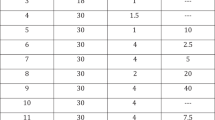Abstract
A study was undertaken of 44 patients who had developed fibrotic changes in the penis in the course of intracavernosal prostaglandin E1 (PGE1) injection therapy for erectile dysfunction. Of these patients, 75.0% (n=33) were followed up for more than 24 months, and 59.1% (n=26) for more than 36 months. Of the patients, 52.3% (n=23) had clinical improvement of the fibrotic changes without therapeutic intervention and despite most (91.3%) continuing intracavernosal PGE1 injection therapy. These included 25.0% (n=11) no longer having clinically detectable penile fibrosis (PF). The presence of penile curvature or pain did not significantly influence this outcome. The ages of men who showed improvement and the duration of their injection therapy were similar to those who did not improve. It would be prudent to defer therapeutic intervention for PF in the course of intracavernosal PGE1 injection therapy in anticipation of possible spontaneous improvement.
This is a preview of subscription content, access via your institution
Access options
Subscribe to this journal
Receive 8 print issues and online access
$259.00 per year
only $32.38 per issue
Buy this article
- Purchase on Springer Link
- Instant access to full article PDF
Prices may be subject to local taxes which are calculated during checkout
Similar content being viewed by others
References
Chew KK . Intracavernosal injection therapy: does it still have a role in erectile dysfunction. Aust Fam Physician 2001; 30: 43–46.
Lakin MM, Montague DK, Schover LR . Fibrosis with intracavernous injection therapy utilizing prostaglandin E1. J Ural 1992; 147: 309A.
Porst H . Experience with alprostadil in diagnosis and therapy in Germany. In: Proceedings of Symposium on The Role of Alprostadil in the Diagnosis and Treatment of Erectile Dysfunction. Goldstein I, Lye TF Excerta Medica Inc.: Princeton, 1993, pp 142–154.
Linet OI, Ogrinc FG . Long-term Safety Study with Alprostadil Sterile Powder in Patients with Erectile Dysfunction. The Upjohn Co. Technical Report, 1993.
Stackl W, Hasun R, Hammar C . Peyronie's disease induced by intracavernous injection of prostaglandin E1. Int J Impot Res 1994; 6(Suppl 1): D30.
Chen RN, Lakin MM, Montague DK, Ausmundson S . Penile scarring with intracavernous injection therapy using prostaglandin E1: a risk factor analysis. J Urol 1996; 155: 138–140.
Mumtaz FH et al. Prostaglandin E1 intracavernmosal injections—longterm results and complications. Int J Impot Res 1996; 7: 120.
Chew KK et al. Penile fibrosis in intracavernmosal prostaglandin E1 injection therapy for erectile dysfunction. Int J Impot Res. 1997; 9: 225–229.
Linet OI, Ogrinc FG. Penile fibrosis during 18 months of intra-cavernosal therapy with alprostadil. Int J Impot Res 1996; 8: 143.
Porst H et al. Final results of a prospective multicentre study with self-injection therapy with PGE1 after 4 y of follow-up. Int J Impot Res 1996; 8: 151.
Author information
Authors and Affiliations
Corresponding author
Rights and permissions
About this article
Cite this article
Chew, K., Stuckey, B. Clinical course of penile fibrosis in intracavernosal prostaglandin E1 injection therapy: a follow-up of 44 patients. Int J Impot Res 15, 94–98 (2003). https://doi.org/10.1038/sj.ijir.3900951
Received:
Accepted:
Published:
Issue Date:
DOI: https://doi.org/10.1038/sj.ijir.3900951
Keywords
This article is cited by
-
Imaging of penile traumas—therapeutic implications
European Radiology (2005)


